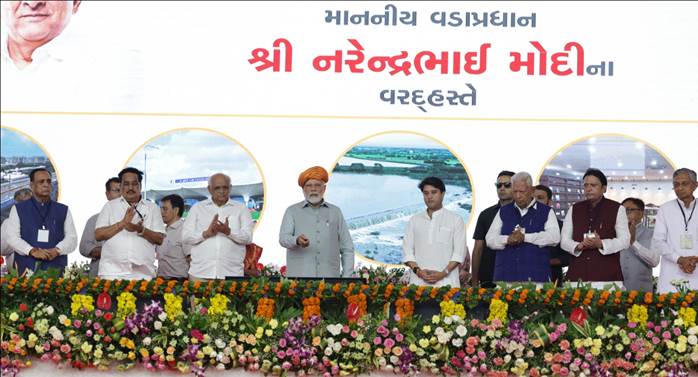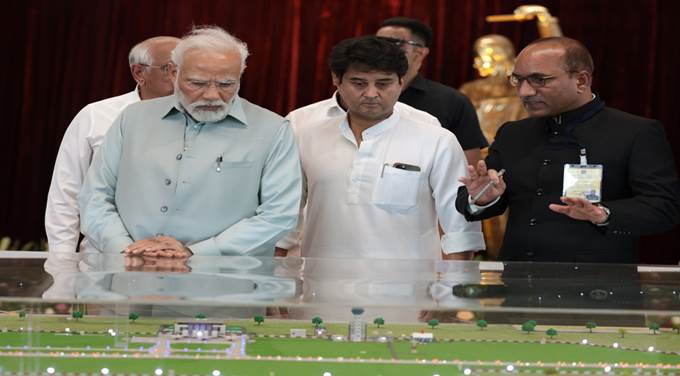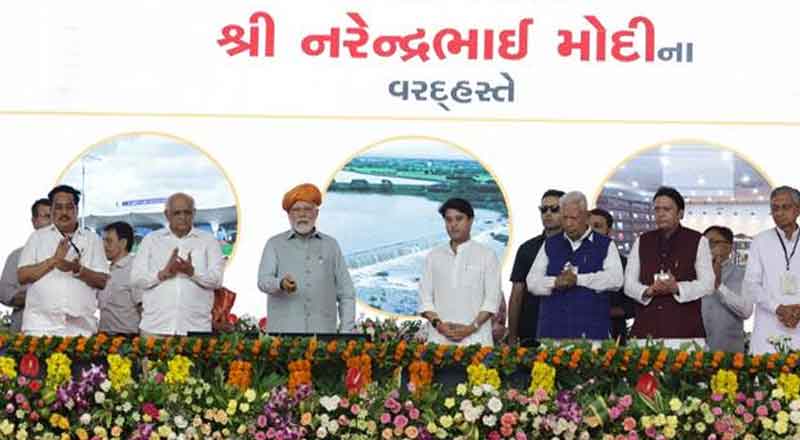Prime Minister Shri Narendra Modi inaugurated the new International Airport in Rajkot today, in the presence of the Chief Minister of Gujarat, Shri Bhupendra Rajnikant Patel, the Union Minister of Civil Aviation , Shri Jyotiraditya M. Scindia, and other dignitaries.
This landmark event marks a significant step towards bolstering the nation’s aviation infrastructure and enhancing connectivity in the region. The 236 acres existing Airport at Rajkot in the state of Gujarat is capacity-constrained due to dense residential and commercial development all around it and does not have any scope for further expansion and to meet Civil Aviation requirements. Therefore, a new Greenfield airport at Hirasar, Rajkot was proposed and was entrusted to the Airports Authority of India. After the proposed New Greenfield Airport becomes operational, the existing Rajkot Airport will cease functioning. To operationalize the Airport with the completed and available airside infrastructure, an Interim Terminal building has been constructed. The new Terminal building is under construction. Once this is completed, the interim Terminal shall be used as Cargo Terminal.

In his address, Shri Jyotiraditya M Scindia said that this airport was envisioned by our Prime Minister around seven years ago. Today he is present here to dedicate this historical gift to the people of Rajkot. The new airport is ten times larger than the existing airport in Rajkot. A new terminal building is also being constructed there, which will have the capacity to serve 1800 passengers per hour. The art and culture of Rajkot will be depicted in this new terminal building.
Shri Scindia further said that in 2014, there were only 56 flight movements per week from Rajkot, which has now more than doubled to 130 flights per week. Currently, Rajkot has air connectivity with Mumbai, Delhi, Pune, Goa, and Bengaluru. In the coming weeks, we are going to connect Rajkot with Udaipur and Indore as well. In 2014, Gujarat had connectivity with only 19 cities; today it is connected to 50 cities.

The New Terminal building and the airside infrastructures are developed in a total land area of 2534 acres and at a cost of Rs.1405 Cr. This development includes the construction of Runway, Apron, Parallel Taxi Track, etc.
Salient Features of the airport:
- New Terminal building sprawls across an area of 23,000 square meters.
- The building can serve up to 2800 passengers during peak hours.
- The terminal is equipped with 20 check-in counters and 5 conveyor belts.
- The runway is 3040 meters in length and 45 meters in width.
- The airport’s apron measures 334 meters by 152 meters.
- Apron can accommodate a fleet of Ten (10) Code-C type and Four (4) Code-B type aircraft simultaneously.
- 2 Link Taxi tracks, each measuring 428 meters by 23 meters.
- The airport has developed a parking area with a capacity to accommodate 300 cars and 75 two-wheelers.
The Terminal Building of Hirasar Airport is equipped with various sustainability features like Double Insulated Roofing System, Canopies for energy saving, LED Lighting, Low Heat Gain Double Glazing Unit, Landscaping with fountains, HVAC, Water treatment plant, Sewage treatment plant and use of recycled water for landscaping, solar power plant to meet GRIHA –IV ratings.
The Hirasar Greenfield Airport has been meticulously planned and developed to meet the burgeoning demands of the aviation industry. To cater to the discerning traveler’s needs, the airport boasts ample space for commercial activities. Furthermore, the design adheres to the Sugamya Bharat Abhiyan norms, ensuring accessibility for all passengers, with the incorporation of tactile paths to enhance the experience of differently abled individuals.
The presence of Prime Minister Narendra Modi and Union Minister of Civil Aviation Shri Jyotiraditya Scindia at the inauguration ceremony underscores the government’s commitment to enhancing India’s aviation sector and bolstering its position on the global aviation map.





